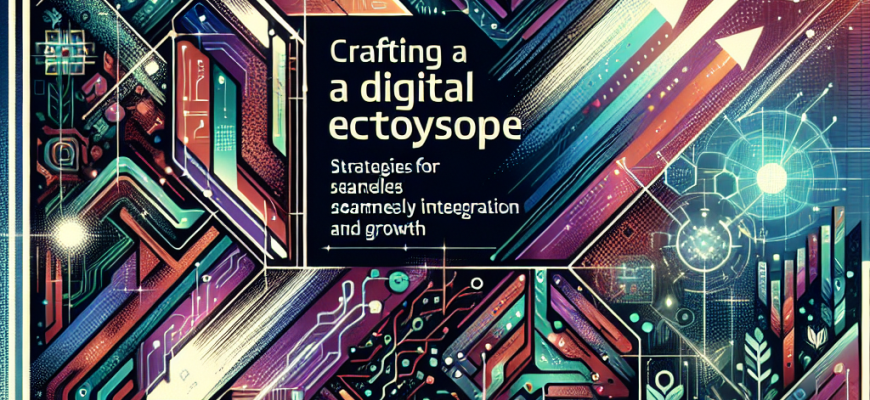- Crafting a Robust Digital Ecosystem: Strategies for Seamless Integration and Growth
- Understanding the Digital Ecosystem
- Strategy 1: Start with a Solid Foundation
- Strategy 2: Choose the Right Tools and Platforms
- Strategy 3: Leverage Data for Personalized Experiences
- Strategy 4: Foster Collaboration Across Teams
- Strategy 5: Continuously Optimize and Innovate
- Strategy 6: Prioritize Security and Compliance
- Strategy 7: Measure Success and Adapt
- The Path Forward
Crafting a Robust Digital Ecosystem: Strategies for Seamless Integration and Growth
In today’s rapidly evolving digital landscape, creating a robust digital ecosystem is paramount for businesses aiming to thrive. A well-integrated digital ecosystem not only enhances operational efficiency but also provides a seamless experience for customers, leading to sustained growth. As a digital marketing expert, I’ve observed and implemented numerous strategies that have proven effective in building such ecosystems. Here, I’ll share insights into crafting a digital environment that fosters integration and growth.
Understanding the Digital Ecosystem
Before diving into strategies, it’s crucial to understand what a digital ecosystem is. Essentially, it’s a complex network of interconnected digital tools and platforms that businesses use to operate and interact with customers. This includes everything from your website and social media channels to CRM systems and email marketing platforms. The goal is to have these components work together seamlessly, creating a unified experience for both the business and its customers.
Strategy 1: Start with a Solid Foundation
The foundation of a robust digital ecosystem is a well-designed, responsive website. Your website should not only reflect your brand’s identity but also be optimized for user experience (UX) and search engine optimization (SEO). It acts as the central hub for your digital presence, where all other digital channels should direct back to. Ensuring your website is fast, mobile-friendly, and secure is non-negotiable in today’s digital age.
Strategy 2: Choose the Right Tools and Platforms
With a plethora of digital tools available, it’s essential to select those that best fit your business needs and integrate well with each other. For instance, your CRM system should seamlessly connect with your email marketing platform and social media management tools. This integration ensures data flows smoothly across your ecosystem, enabling personalized and timely interactions with your audience.
Strategy 3: Leverage Data for Personalized Experiences
Data is the lifeblood of a digital ecosystem. Collecting and analyzing data from various touchpoints allows businesses to understand customer behavior and preferences. This insight enables the creation of personalized experiences, which are key to building customer loyalty and driving growth. Implementing a robust data management platform that can aggregate and analyze data across your ecosystem is critical.
Strategy 4: Foster Collaboration Across Teams
A digital ecosystem doesn’t operate in a vacuum. It requires collaboration across various departments within a business, from marketing and sales to IT and customer service. Encouraging open communication and collaboration ensures that everyone is aligned with the digital strategy and working towards the same goals. Tools like project management software and collaboration platforms can facilitate this cross-departmental cooperation.
Strategy 5: Continuously Optimize and Innovate
The digital landscape is constantly changing, with new technologies and customer expectations evolving at a rapid pace. To keep your digital ecosystem robust, it’s vital to stay on top of these changes and continuously optimize your strategies. This could mean updating your website, experimenting with new digital marketing tactics, or incorporating emerging technologies like AI and machine learning into your ecosystem.
Strategy 6: Prioritize Security and Compliance
As your digital ecosystem grows, so does the risk of cyber threats and data breaches. Ensuring the security of your digital platforms and the privacy of customer data is paramount. This includes implementing strong cybersecurity measures, adhering to data protection regulations, and regularly auditing your ecosystem for vulnerabilities. A secure digital ecosystem not only protects your business but also builds trust with your customers.
Strategy 7: Measure Success and Adapt
Finally, to ensure your digital ecosystem is driving growth, it’s important to measure its performance against your business objectives. This involves setting key performance indicators (KPIs) for different components of your ecosystem and regularly reviewing analytics to gauge success. Based on these insights, be prepared to adapt your strategies to optimize performance and achieve your growth targets.
The Path Forward
Crafting a robust digital ecosystem is not a one-time effort but a continuous journey of integration, optimization, and growth. By starting with a solid foundation, choosing the right tools, leveraging data, fostering collaboration, continuously innovating, prioritizing security, and measuring success, businesses can create a digital environment that not only meets the needs of today’s digital-first customers but also drives sustained growth.
Remember, the key to a successful digital ecosystem is its ability to evolve. As digital marketing experts, our role is to guide this evolution, ensuring our businesses remain competitive and relevant in the ever-changing digital landscape. By embracing these strategies, we can build digital ecosystems that are not just robust but also resilient, adaptable, and poised for future growth.

A seasoned digital marketing strategist with over 8 years of experience across various areas of digital marketing, including SEO, SMM, PPC, content marketing, and email marketing. Specializes in transforming B2B, B2C, e-commerce, and SaaS businesses by creating effective go-to-market strategies and building thriving digital ecosystems. Known for a data-driven approach to optimizing campaigns and maximizing results.
“If your business is looking to scale or in need of a fresh perspective, feel free to contact”.





